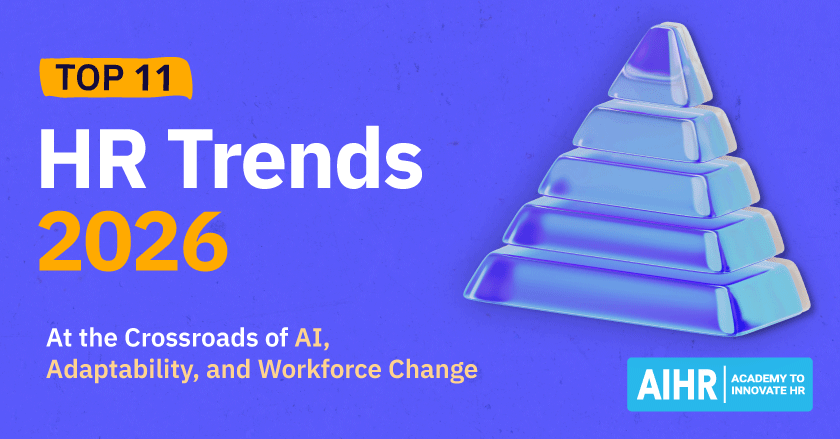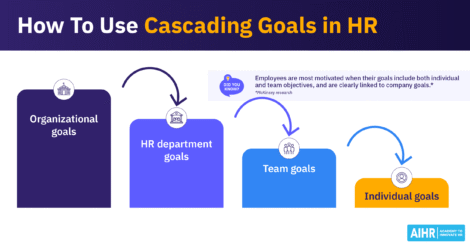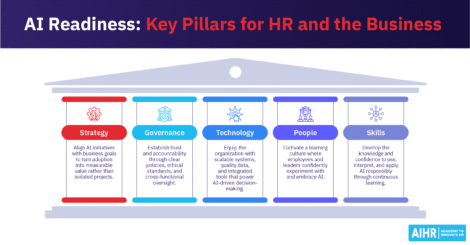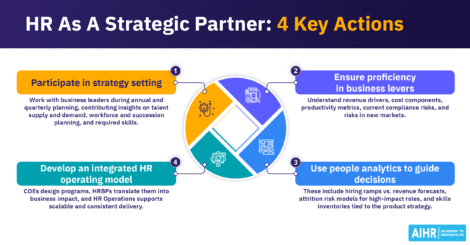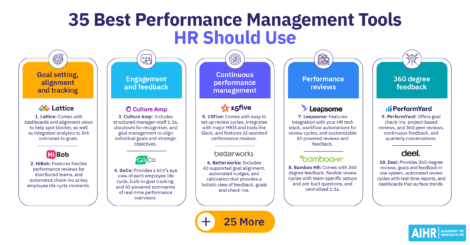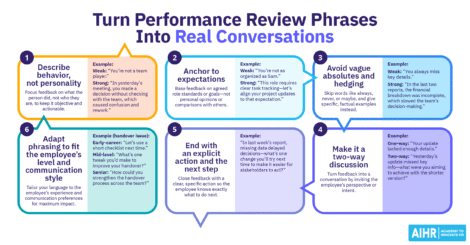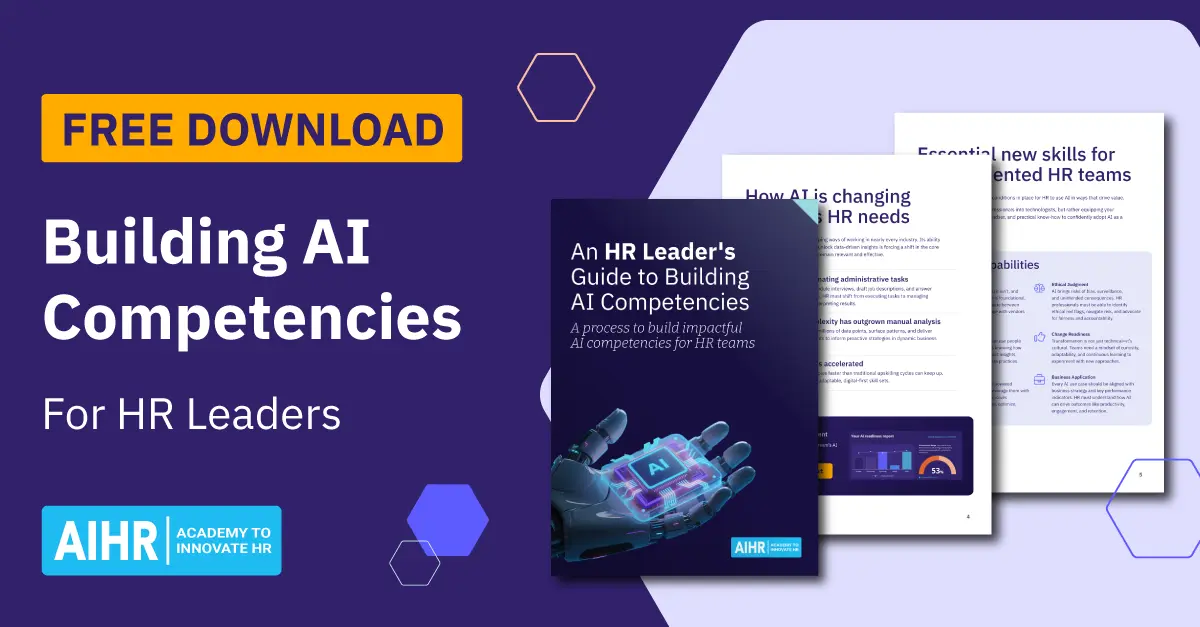The HR role in crisis management has become a central pillar of organizational resilience. When a crisis hits a company, its most critical assets — i.e., its people — are immediately at risk. This makes a sound crisis management strategy necessary to protect the business, reinforce employee trust, and maintain operational continuity.
In fact, 75% of organizations activated their crisis management team in just one year, underscoring the need for HR-led people operations (communications, wellbeing, and staffing) to be crisis-ready. This article discusses crisis management in HR, how to spot and prevent a crisis, and HR’s responsibilities during and after a crisis.
Contents
What is crisis management in HR?
Signs of crisis to watch for
5 types of crises and how to handle them
HR’s responsibilities in crisis management
HR’s responsibilities in post-crisis recovery
HR crisis management case studies
10 useful HR crisis management strategies
What is crisis management in HR?
HR crisis management is the strategic process of planning, coordinating, and leading workforce-related responses during a major internal or external disruption. Its primary purpose is to protect employee safety, ensure global and local compliance, and sustain business operations in the face of unexpected events.
Beyond logistics, effective HR crisis management is crucial for reinforcing employee trust in leadership, mitigating organizational risks, and ensuring long-term resilience. Proactively addressing potential threats and having a clear plan turns HR from a support role into a central driver of organizational stability and employee wellbeing in times of uncertainty.
Signs of crisis to watch for
Crises don’t always arrive with the immediacy and intensity of environmental disasters — some are slow-burning (e.g., slumping stock prices or customer confidence) and can lead to an exodus of key staff, eroding the business from the inside out.
This is why HR professionals must be vigilant, actively monitoring both overt and subtle indicators of an impending crisis. You can be proactive instead of reactive by detecting these signs early, enabling a more measured and effective response. Look out for these key signs:
Warning signs in employees
Watch for indicators that reflect a decline in employee wellbeing and engagement, which can signal broader systemic issues. Signs include an increase in absenteeism and presenteeism, higher rates of reported mental health issues, a noticeable drop in collaboration, or a rise in workplace conflicts.
Organizational signs
Company-wide metrics can point to a developing crisis. A persistent drop in productivity and quality, a growing number of data or security breaches, and negative reputational hits on social media or review platforms are all red flags. Unforeseen leadership changes or budget cuts can also lead to instability.
External factors
External signs of crisis include significant economic downturns, unexpected legal or regulatory changes that impact businesses, and public health emergencies. Staying on top of geopolitical shifts and changes in consumer behavior is also essential for anticipating and mitigating their effects on your organization.
5 types of crises and how to handle them
Understanding different types of crises and the risks associated with each one can enable a successful response and recovery on your organization’s part. Here are five types of crises and how you can handle them:
Type 1: Health and safety crises
Examples
- The COVID-19 pandemic
- Natural disasters like earthquakes, floods, or volcanic eruptions
- A serious workplace accident, such as a fire or explosion.
Solution
HR must ensure preparedness through well-documented safety plans and proactive training sessions that teach managers and employees how to respond effectively. Access to comprehensive health support and a clear, consistent communication channel are critical for guiding the workforce through such crises.
For instance, during a pandemic, HR’s role involves creating or refining remote work policies, sourcing personal protective equipment, implementing wellness checks, and opening a dedicated channel for updates and communication on the crisis.
Type 2: Workforce-related crises
Examples
- A series of mass layoffs
- A protracted labor strike
- An exceptionally high spike in employee turnover
- A severe talent shortage in a key area.
Solution
Address these disruptions with transparent and empathetic communication to maintain trust. Constructive negotiations with unions or disgruntled employees can de-escalate conflicts, while strategic retention programs and predictive workforce planning can help address talent shortages before they become critical.
During mass layoffs, for instance, HR’s role is to ensure fair and compliant severance packages, provide outplacement support, and communicate with remaining employees to rebuild morale and confidence.
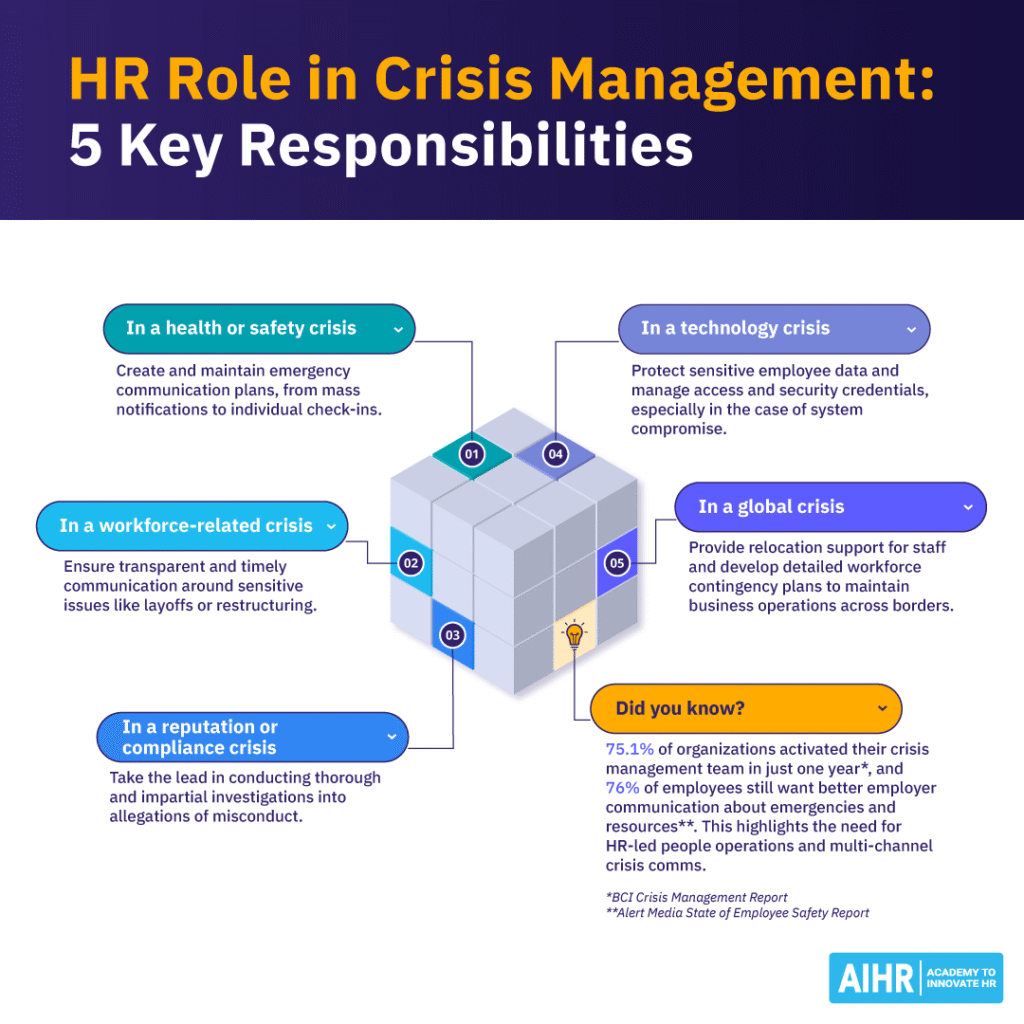
Type 3: Reputation and compliance crises
Examples
- Widespread harassment claims
- Discrimination lawsuits
- Significant labor law violations
- Public backlash to your company’s actions.
Solution
Protect your organization by rigorously enforcing policies and codes of conduct. This includes swiftly and impartially investigating all claims, providing mandatory staff training on ethics and compliance, and creating safe, confidential channels to protect whistleblowers.
For example, responding to a harassment claim involves a thorough investigation process, appropriate disciplinary actions, and a public relations strategy that shows your company is taking the matter seriously.
Type 4: Technology crises
Examples
- A large-scale cybersecurity breach that compromises employee data
- A critical Human Resources Information System (HRIS) failure
- A data privacy violation.
Solution
Mitigate these risks with strong data protection protocols and mandatory employee training on cybersecurity best practices. You must also work closely with your IT department to ensure backup systems are in place.
At the same time, maintain open and honest communication with your employees during a breach, and provide clear instructions on any steps they must take to protect their personal information.
Type 5: Global or geopolitical crises
Examples
- The outbreak of war in a region where employees are located
- The imposition of international sanctions
- Cross-border employment disruptions.
Solution
Maintain business continuity by ensuring compliance with evolving international labor laws, enabling flexible work arrangements, and supporting the safe relocation of employees and their families where necessary. Building contingency plans for global operations is critical when navigating these complex scenarios.
For example, in a geopolitical crisis, HR might be responsible for securing travel visas for employees who need to leave a region and working with legal counsel to navigate complex sanctions. Understanding these procedures and ensuring the right contacts in advance can be critical for successful extraction and response.
A crisis management protocol is just one part of the equation. To protect the business and workforce in the long term, HR needs a resilience strategy that combines clear roles, scenario planning, transparent communication, and cross-training.
With AIHR for Business, your team will learn to:
✅ Ensure plans and projects are both effective and aligned with business objectives
✅ Master data analytics, execution frameworks, and agile methodologies
✅ Connect with peers and learn best practices for different aspects of the HR function
🎯 Don’t just react to crises — enable HR preparedness and crisis prevention.
HR’s responsibilities in crisis management
HR manages the human and operational response. To limit damage and support recovery, you must act fast, coordinate across teams, and communicate with empathy. It’s also crucial to address employee emotions by tackling root causes while executing practical steps.
Below are HR’s key responsibilities in the management of different types of crises:
In a health or safety crisis
HR is responsible for creating and maintaining emergency communication plans, including mass notifications and individual check-ins. You must also implement and enforce workplace safety protocols and provide access to vital employee assistance programs (EAPs) that support your workforce’s physical and psychological wellbeing.
In a workforce-related crisis
When managing workforce disruptions, your primary responsibility is to ensure transparent and timely communication on sensitive issues like layoffs or restructuring. You must mediate workplace conflicts, lead sensitive union negotiations, and manage a fair and compliant process to minimize legal and reputational risk.
In a reputation or compliance crisis
In these situations, HR takes the lead in conducting thorough, impartial investigations into allegations of misconduct. You must enforce company policies fairly and consistently, and manage your organization’s legal exposure by coordinating with legal teams. You must also ensure all decisions and actions are fully compliant with relevant labor laws.
In a technology crisis
For tech-related crises, HR is responsible for protecting sensitive employee data. You must coordinate with your IT department to communicate updates and next steps to your workforce and manage employee access and security credentials, especially if a system has been compromised.
In a global or geopolitical crisis
When a global event impacts your workforce, HR responsibilities include providing immediate relocation support for employees and their families, and developing detailed workforce contingency plans to maintain business operations across borders. In the case of sanctions, you must ensure compliance with international labor laws.
HR’s responsibilities in post-crisis recovery
The end of a crisis does not signal the end of HR’s work. Instead, it marks the beginning of the recovery phase. The post-crisis period is a critical time for rebuilding, learning, and preparing for the future. Here are key HR responsibilities after handling a crisis:
Rebuild employee trust and morale
As HR, you must actively listen to employees, communicate lessons learned, and implement new policies that unequivocally demonstrate your organization’s commitment to its workforce’s wellbeing. This helps rebuild and maintain trust among employees, encouraging them to remain with the company and improving your company’s employer brand.
Conduct debriefs and document lessons learned
It’s essential to analyze your crisis response after the dust has settled. HR should lead debriefing sessions to determine and communicate what worked, what didn’t, and why. You must also document these findings to help inform and improve future contingency plans for crisis management so you can be better prepared and avoid repeating mistakes.
Update crisis playbooks for future preparedness
Based on your debriefing sessions, you must update and refine your company’s crisis management playbook by incorporating new procedures and communicating these protocols. Additionally, remember to update your entire team’s contact and next-of-kin information whenever necessary. This enables you to inform the right people during a crisis.
Support workforce reintegration
Whether your company’s employees are returning from remote work, layoffs, or a temporary relocation, the HR department is responsible for a smooth reintegration process. This includes providing the necessary resources to support this process and fostering a sense of community to give employees a sense of belonging and security.
Strengthen your employer branding
After any disruption, as HR, you need to proactively work on your employer brand to retain top talent and attract new talent. Focus your efforts on ensuring your organization is perceived as a stable and reliable place to work.
HR crisis management case studies
Understanding the theoretical framework of HR crisis management is one thing; seeing it in action is another. Here are two real-world examples that outline how HR led the response to complex organizational crises.
Case study 1: Airbnb’s COVID-19 layoff response
When the COVID-19 pandemic crippled the travel industry, Airbnb decided it had to lay off nearly 25% of its workforce. Rather than a standard, impersonal announcement, CEO Brian Chesky published a widely praised open letter that was later considered a gold standard for empathetic layoff communication.
What worked: Airbnb’s HR team worked with leadership to craft a transparent message explaining the decision. The company’s generous severance packages also exceeded the norm, offering 14 weeks of pay, a year of health insurance, and outplacement assistance. They also created an opt-in talent directory to help laid-off employees find new jobs.
What didn’t: Despite a strong overall response, some reports from contract employees indicated that their severance and support packages were less comprehensive than those offered to full-time staff, highlighting an area for improvement in equitable crisis response.
Lessons learned: This case study demonstrates the power of transparent and empathetic communication. By prioritizing the human element, Airbnb’s HR and leadership team mitigated reputational damage and enhanced their employer brand.
Case study 2: Starbucks’ racial bias incident
In 2018, two Black men who’d been waiting for a friend and wanted to use the restroom before placing their orders were arrested at a Philadelphia Starbucks after a store employee reported them to the police for allegedly “trespassing”. The incident sparked national outrage, highlighting systemic racial bias and threatening the company’s reputation.
What worked: HR responded swiftly, Starbucks immediately issued a public apology, and changed its policy to allow anyone to use its restrooms regardless of purchase. Most notably, it closed over 8,000 U.S. stores for an afternoon of mandatory racial bias training for 175,000 staff. This demonstrated a commitment to addressing the root cause of the crisis.
What didn’t: The incident itself and subsequent public backlash revealed that employee behavior did not consistently reflect the company’s stated values of inclusivity. While the mandatory training was a necessary step in this instance, it should have been part of new hire training and onboarding instead of a reactive solution to an avoidable situation.
Lessons learned: This crisis highlighted the importance of matching corporate values with concrete action. HR must not only have a plan to respond to a crisis but must also actively work to create a culture of psychological safety at work, and accountability that can prevent such events from occurring in the first place.
10 useful HR crisis management strategies
A well-crafted crisis management plan is your best defense against unforeseen events. Integrating these strategies can significantly enhance your company’s response and resilience.
1. Create a crisis communication plan
Build a clear, transparent, and timely plan that spells out who communicates what, to whom, and through which channels. Include message templates, approval steps, and a contact tree for rapid outreach. Set SLAs for updates, define when to escalate, and test the plan quarterly to ensure it works under pressure.
2. Develop a cross-functional crisis response team
Form a core team with leaders from HR, Legal, IT, Operations, and Communication, and assign clear roles, a single decision owner, and backups. Set up a rapid meeting cadence and a shared dashboard for status, risks, and actions, and document handoffs so nothing falls through the cracks.
3. Train leaders and managers to respond consistently
Equip managers with practical training on tough conversations, de-escalation, and delivering hard news. Provide talk tracks, FAQs, and do/don’t guidelines to keep messages aligned. Run short simulations to build confidence and measure readiness with quick pulse checks.
4. Invest in employee assistance programs (EAPs)
Make EAP access easy and confidential, and promote it before, during, and after a crisis. EAPs should cover mental health, financial counseling, legal advice, and caregiving resources. You must also train managers to spot distress and refer early, as well as track usage trends to adjust support.
5. Run scenario planning and simulation exercises
Run tabletop drills and live simulations for likely scenarios, such as a data breach, facility closure, or supply disruption. Next, stress-test decision paths, communication speed, and role clarity. You should also identify gaps and assign owners to fix them. Repeat this process at least twice a year to keep it fresh in the mind.
6. Build flexible HR policies
Create HR policies that allow remote work, flexible schedules, and emergency leave without red tape, and pre-approve exceptions you’ll need in a crisis, like expanded PTO or stipend use. Publish simple, plain-language guidance for employees and managers, review policies after each incident, and tighten them where needed.
7. Use technology for rapid response
Use HRIS alerts, internal chat, SMS, and a crisis page on your intranet to push updates quickly. Maintain accurate contact info and segment messages by location or role, and enable two-way feedback so employees can ask questions or report issues. At the same time, be sure to monitor engagement to confirm reach.
8. Foster a culture of psychological safety
Set the tone by inviting concerns and thanking people who raise risks early, while also protecting anonymity when needed and making non-retaliation the norm. Additionally, train leaders to listen first and respond with facts and empathy. It’s also important to close the loop, so employees see action taken based on their input.
9. Develop a global risk matrix
Map risks by country and region — political, health, weather, legal, and cyber — and rate them by likelihood and impact. Then, tie each risk to triggers, owners, and playbooks, and align policies with local laws and cultural norms. Finally, review the matrix quarterly and after major events to ensure it’s up-to-date and relevant.
10. Establish clear post-crisis protocols
Define a recovery playbook that covers debriefs, documentation, policy updates, and stakeholder follow-ups. Measure impact on people, operations, and brand, and share lessons learned. Outline steps to rebuild trust—listening sessions, leadership check-ins, and visible fixes. Set milestones to return to steady state and track them openly.
How HR can help prevent an impending crisis
The most effective form of crisis management is actually crisis prevention through planning and proactive action. As an HR professional, you can use your understanding of your workforce and organizational culture to identify and mitigate risks before they escalate into a full-blown crisis.
- Proactively conduct risk assessments and employee surveys: Regularly conduct assessments and anonymous employee surveys to catch issues early (e.g., low morale, burnout, or dissatisfaction) before they fester and lead to a crisis.
- Implement employee engagement programs: Use these programs to actively engage employees and foster a positive workplace culture by building a sense of community and trust that can withstand external pressures.
- Continuously monitor compliance and workplace culture: Continuously track compliance with all labor laws and conduct regular audits to ensure that workplace culture aligns with organizational values and ethical standards.
- Build resilience through training and mental health support: Provide training on stress management and resilience, and ensure employees have access to mental health resources to help them cope better with challenges.
- Benchmark global best practices in crisis readiness: Stay informed on global trends and best practices in crisis readiness, and learn from other organizations and industries to help proactively strengthen your organization’s capabilities.
To sum up
Strong HR crisis management protects people, preserves operations, and sustains trust. The signals are clear: most employees want better communication in emergencies, and most organizations have already activated crisis teams. Your job is to bridge that gap — spot risks early, act fast, and communicate with clarity and empathy while staying compliant.
You should also make this standard practice instead of a one-off response to crises. Codify roles, test your plans, invest in wellbeing, and update playbooks after every incident. When HR leads with discipline and care, you reduce harm, speed recovery, and strengthen your employer brand, turning crises into proof points of resilience.


